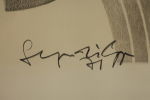Auction 114 Part 3
Fine Art, Ceramics, Metalware & Sculptures
By Auktionshaus Mehlis
Contact auction house
May 25, 2024
Hammerstraße 30, 8523 Plauen, Germany
Terms of sale
View demo
The auction has ended
|
LOT 3839:
György Segesdi, Zwei geometrische Kompositionen
more...
|
|





|
Sold for: €220
Price including buyer’s premium:
€
279.40
Start price:
€
100
Buyer's Premium: 27%
VAT: 19%
On commission only
Users from foreign countries may be exempted from tax payments, according to the relevant tax regulations
|
György Segesdi, Zwei geometrische Kompositionen
György Segesdi, Zwei geometrische Kompositionen
zwei geometrische Kompositionen; die berühmten Plastiken des vielfach ausgezeichneten ungarischen Künstlers Segesdi sind in Stil und Linienführung analog zu den vorliegenden Werken auf Papier, erstere sind in zahlreichen ungarischen Städten zu bestaunen, darunter das "Flood Memorial" in Szeged, in Budapest finden sich etwa vor dem Novotel Budapest oder an der Pozsonyi-Straße große Skulpturen von ihm, je Lithographie auf Japan unten rechts von Hand signiert und datiert "Segesdi [19]71", sowie hinter Glas in dezenter Leiste ansprechend gerahmt, Darstellungsmaße ca. 77 x 53 bzw. 85 x 53 cm. Künstlerinfo: ungarischer Bildhauer (1931 Budapest bis 2021 Budapest), von 1949 bis 1954 an der Ungarischen Akademie der Schönen Künste bei Zsigmond Kisfaludi Strobl, Iván Szabó und András Beck, 1963 Teilnahme an der Pariser Biennale, im Jahr darauf auf der Biennale von Venedig, zunächst Fokus auf figurative Skulpturen, ab den 1960er Jahren Hinwendung zu Blechskulpturen, ab den 1970er Jahren kam in seinen Werken zunehmend Plexiglas zum Einsatz, ab 1976 Lehrauftrag an der Ungarischen Akademie für Angewandte Kunst als Leiter der Abteilung für Silikatindustrie, von 1987 bis 1997 außerordentlicher Professor der Bildhauereiabteilung der Ungarischen Akademie der Schönen Künste, zweifach mit dem Mihály-Munkácsy-Preis ausgezeichnet.
György Segesdi, Two Geometric Compositions
Two geometric compositions; the famous sculptures by the multi-award-winning Hungarian artist Segesdi are analogous in style and line to the present works on paper, the former can be admired in numerous Hungarian cities, including the "Flood Memorial" in Szeged, in Budapest there are large sculptures by him in front of the Novotel Budapest or on Pozsonyi Street, each lithograph on Japan signed and dated by hand lower right "Segesdi [19]71", and attractively framed behind glass in a discreet moulding, dimensions approx. 77 x 53 and 85 x 53 cm respectively. Artist information: Hungarian sculptor (1931 Budapest - 2021 Budapest), from 1949 to 1954 at the Hungarian Academy of Fine Arts under Zsigmond Kisfaludi Strobl, Iván Szabó and András Beck, 1963 participation in the Paris Biennale, the following year at the Venice Biennale, initially focussing on figurative sculptures, from the 1960s onwards turning to sheet metal sculptures, from the 1970s, Plexiglas was increasingly used in his works, from 1976 teaching position at the Hungarian Academy of Applied Arts as head of the Department of Silicate Industry, from 1987 to 1997 associate professor at the Sculpture Department of the Hungarian Academy of Fine Arts, twice awarded the Mihály Munkácsy Prize.
zwei geometrische Kompositionen; die berühmten Plastiken des vielfach ausgezeichneten ungarischen Künstlers Segesdi sind in Stil und Linienführung analog zu den vorliegenden Werken auf Papier, erstere sind in zahlreichen ungarischen Städten zu bestaunen, darunter das "Flood Memorial" in Szeged, in Budapest finden sich etwa vor dem Novotel Budapest oder an der Pozsonyi-Straße große Skulpturen von ihm, je Lithographie auf Japan unten rechts von Hand signiert und datiert "Segesdi [19]71", sowie hinter Glas in dezenter Leiste ansprechend gerahmt, Darstellungsmaße ca. 77 x 53 bzw. 85 x 53 cm. Künstlerinfo: ungarischer Bildhauer (1931 Budapest bis 2021 Budapest), von 1949 bis 1954 an der Ungarischen Akademie der Schönen Künste bei Zsigmond Kisfaludi Strobl, Iván Szabó und András Beck, 1963 Teilnahme an der Pariser Biennale, im Jahr darauf auf der Biennale von Venedig, zunächst Fokus auf figurative Skulpturen, ab den 1960er Jahren Hinwendung zu Blechskulpturen, ab den 1970er Jahren kam in seinen Werken zunehmend Plexiglas zum Einsatz, ab 1976 Lehrauftrag an der Ungarischen Akademie für Angewandte Kunst als Leiter der Abteilung für Silikatindustrie, von 1987 bis 1997 außerordentlicher Professor der Bildhauereiabteilung der Ungarischen Akademie der Schönen Künste, zweifach mit dem Mihály-Munkácsy-Preis ausgezeichnet.
Two geometric compositions; the famous sculptures by the multi-award-winning Hungarian artist Segesdi are analogous in style and line to the present works on paper, the former can be admired in numerous Hungarian cities, including the "Flood Memorial" in Szeged, in Budapest there are large sculptures by him in front of the Novotel Budapest or on Pozsonyi Street, each lithograph on Japan signed and dated by hand lower right "Segesdi [19]71", and attractively framed behind glass in a discreet moulding, dimensions approx. 77 x 53 and 85 x 53 cm respectively. Artist information: Hungarian sculptor (1931 Budapest - 2021 Budapest), from 1949 to 1954 at the Hungarian Academy of Fine Arts under Zsigmond Kisfaludi Strobl, Iván Szabó and András Beck, 1963 participation in the Paris Biennale, the following year at the Venice Biennale, initially focussing on figurative sculptures, from the 1960s onwards turning to sheet metal sculptures, from the 1970s, Plexiglas was increasingly used in his works, from 1976 teaching position at the Hungarian Academy of Applied Arts as head of the Department of Silicate Industry, from 1987 to 1997 associate professor at the Sculpture Department of the Hungarian Academy of Fine Arts, twice awarded the Mihály Munkácsy Prize.

